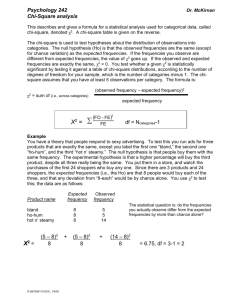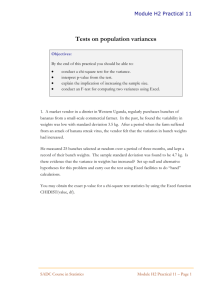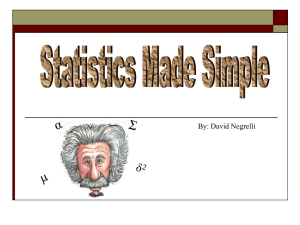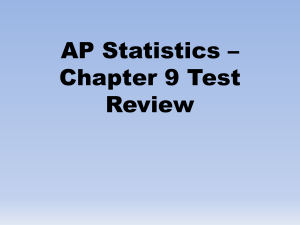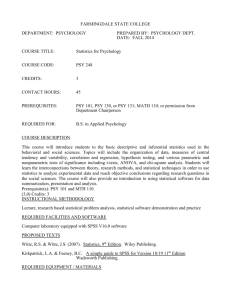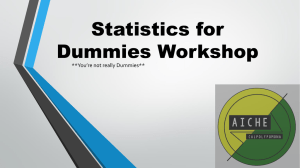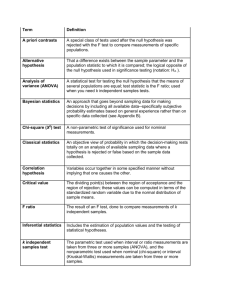Parametric/Nonparametric Tests
advertisement
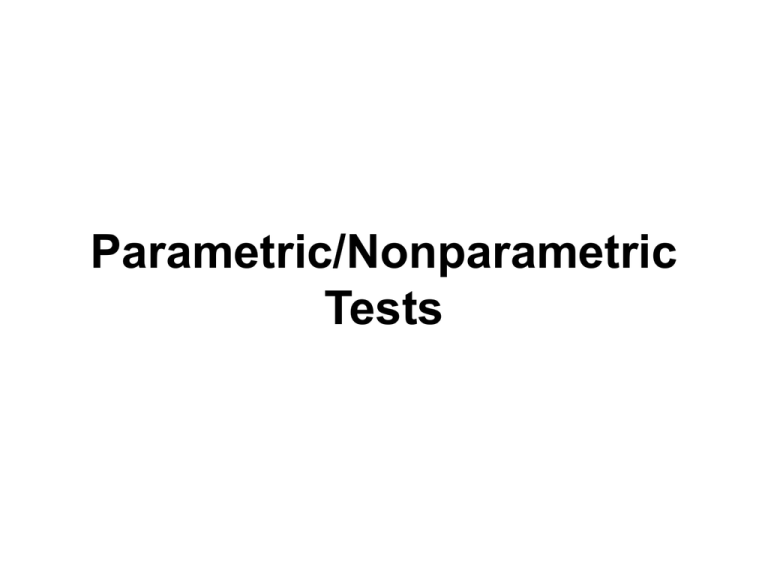
Parametric/Nonparametric Tests Chi-Square Test • It is a technique through the use of which it is possible for all researchers to: test the goodness of fit; Test the significance of association between two attributes; and Test the homogeneity or the significance of population variance. Chi-Square as a Parametric Test • The chi-square value is often used to judge the significance of population variance i.e., • We can use the test to judge if a random sample has been drawn from a normal population with mean (μ) and with a specified variance (σ-square). How to Select a Test? • To choose a particular significance test, the researcher should consider at least three questions: Does the test involve one sample, two samples, or k samples? If more than one sample are involved, are the individual cases independent or related? Is the measurement scale nominal, ordinal, interval, or ratio? One-Sample Tests • One sample tests are used when we have a single sample and wish to test the hypothesis that it comes from a specified population. • In this case, the following questions are encountered: Is there a difference between observed frequencies and the frequencies we would expect, based on some theory? One-Sample Tests contd. Is there a difference between observed and expected proportions? Is it reasonable to conclude that sample is drawn from a population with some specified distribution (normal, etc.). Is there significant difference between some measures of central tendency (X bar) and its population parameter (μ). Parametric Tests • The Z or t-test is used to determine the statistical significance between a sample statistic and a population parameter. • Choose the t-test if the data are ratio measurement. Assume the underlying population is normal and we have randomly selected the sample from the study population. Chi-square Test • Chi-square as a test of population variance is used to work out the value of X2 to test the null hypothesis: Ho: σ2s = σ2p • X2 = σ2s / σ2p (n-1) • Where σ2s = Variance of the sample; σ2p = Variance of the population; (n-1) = Degrees of freedom, n being the number of items in the sample. Chi-square Test • By comparing the calculated value with the table value of X2 for (n-1) degrees of freedom at a given level of significance, we may either accept or reject the null hypothesis. • If the calculated value of X2 is less than the table value, the null hypothesis is accepted. • If the calculated value of X2 is equal to or greater than the table value, the hypothesis is rejected. X2 as a Non-parametric Test • As a Non-parametric test, Chi-square can be used (i) as a test of goodness of fit and (ii) as a test of independence. X2 as a test of goodness of fit • This test enables us to see how well does the assumed theoretical distribution fit to the observed data. • If the calculated value of X2 is less than the table value at a certain level of significance, the fit is considered to be a good one which means that the divergence between the observed and expected frequencies is attributable to fluctuations of sampling. • If the calculated value of X2 is greater than its table value, the fit is not considered good. X2 as a test of independence • X2 enables us to explain whether or not two attributes are associated. • Example: We may be interested in knowing whether a new medicine is effective in controlling fever or not, X2 test will help us in deciding this issue. X2 as a test of independence • In such a situation, we proceed with the null hypothesis that the two attributes (new medicine and control of fever) are independent which means that the new medicine is not effective in controlling fever. • On this basis, we first calculate the expected frequencies and then work out the value of X2. X2 as a test of independence • If the calculated value of X2 is less than the table value at certain level of significance for given degrees of freedom, we conclude that null hypothesis stands which means that the two attributes are independent or not associated. • In the opposite case, hypothesis holds good which means that the two attributes are associated and the association is not because of some chance factor and it exists in reality. Illustration 2 • A die is thrown 132 times with the following results: • -------------------------------------------------------• • • • • Number turned up 1 2 3 4 5 6 Frequency 16 20 25 14 29 28 --------------------------------------------------------------------------Is the die unbiased? Let us hypothesize that the die is unbiased. If that is so, the probability of obtaining any one of the six numbers is 1/6 and as such the expected frequency of any one number coming upward is 132 x 1/6 = 22. Illustration 2 No. turned Observed Expected Oi –Ei up frequency frequency Oi Ei (Oi –Ei)2 (Oi –Ei)2/ Ei 1 16 22 -6 36 36/22 2 20 22 -2 4 4/22 3 25 22 3 9 9/22 4 14 22 -8 64 64/22 5 29 22 7 49 49/22 6 28 22 6 36 36/22 Illustration 2 • Σ[(Oi –Ei)2/Ei ] = 9 [198/22] • Hence, the calculated value of X2 = 9. • Degrees of freedom in the given problem is (n-1) = (6-1) = 5. • The table value of X2 for 5 degrees of freedom at 5% level of significance is 11.071. Comparing calculated and table values of X2, we find that the calculated value is less than the table value and as such could have arisen due to fluctuations of sampling. • The result, thus, supports the hypothesis and it can be concluded that the die is unbiased

